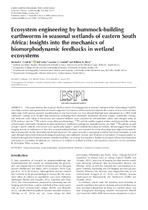| dc.contributor.author | Grenfell, Michael C. | |
| dc.contributor.author | Aalto, Rolf | |
| dc.contributor.author | Grenfell, Suzanne E. | |
| dc.contributor.author | Ellery, William N. | |
| dc.date.accessioned | 2019-10-10T13:11:37Z | |
| dc.date.available | 2019-10-10T13:11:37Z | |
| dc.date.issued | 2018 | |
| dc.identifier.citation | Grenfell, M. C., Aalto, R., Grenfell, S. E., and Ellery, W. N. ( 2019) Ecosystem engineering by hummock‐building earthworms in seasonal wetlands of eastern South Africa: Insights into the mechanics of biomorphodynamic feedbacks in wetland ecosystems. Earth Surf. Process. Landforms, 44: 354– 366. https://doi.org/10.1002/esp.4497. | en_US |
| dc.identifier.issn | 1096-9837 | |
| dc.identifier.uri | https://doi.org/10.1002/esp.4497 | |
| dc.identifier.uri | http://hdl.handle.net/10566/5026 | |
| dc.description.abstract | This paper resolves the origin of clay hummock micro-topography in seasonal wetlands of the Drakensberg Foothills,
providing a review and appraisal of previously-suggested mechanisms of hummock formation in the context of new field and laboratory
data. Field surveys revealed neo-formation of clay hummocks in a river channel that had been abandoned in c.1984. Fresh
earthworm castings were located atop hummocks protruding from inundated abandoned channel margins. Earthworm castings,
and sediment cores taken in hummocks and adjacent hollows, were analysed for soil-adsorbed carbon and nitrogen using an
HCN analyser, and for 210Pb activity using alpha-geochronology. 210Pb activity profiles suggest relative enrichment of the isotope
in hummocks, and relative depletion in adjacent hollows. Earthworm castings are characterised by very high 210Pb activity, as well
as high C and N contents. Hummocks have significantly higher C and N contents than adjacent hollows. Results suggest that it is the
foraging activity of earthworms in litter-rich seasonal wetland hollows, and repeated excretion of castings atop adjacent hummocks,
that is responsible for the elemental enrichment observed. The paper presents a conceptual model of hummock formation in wetlands
through interactions between hydrogeomorphology and earthworm activity, and illustrates a mechanism of biogeomorphic inheritance
through which ordered patterns of preferential flow can emerge in ecosystems. Further implications of hummock formation
and nodal accumulation of nutrients are considered in relation to wetland resilience and regulatory ecosystem service provision. | en_US |
| dc.language.iso | en | en_US |
| dc.publisher | Wiley | en_US |
| dc.subject | Biogeomorphology | en_US |
| dc.subject | Zoogeomorphology | en_US |
| dc.subject | Biopedoturbation | en_US |
| dc.subject | Wetlands | en_US |
| dc.subject | Ecosystem services | en_US |
| dc.title | Ecosystem engineering by hummock-building earthworms in seasonal wetlands of eastern South Africa: Insights into the mechanics of biomorphodynamic feedbacks in wetland ecosystems | en_US |
| dc.type | Article | en_US |

